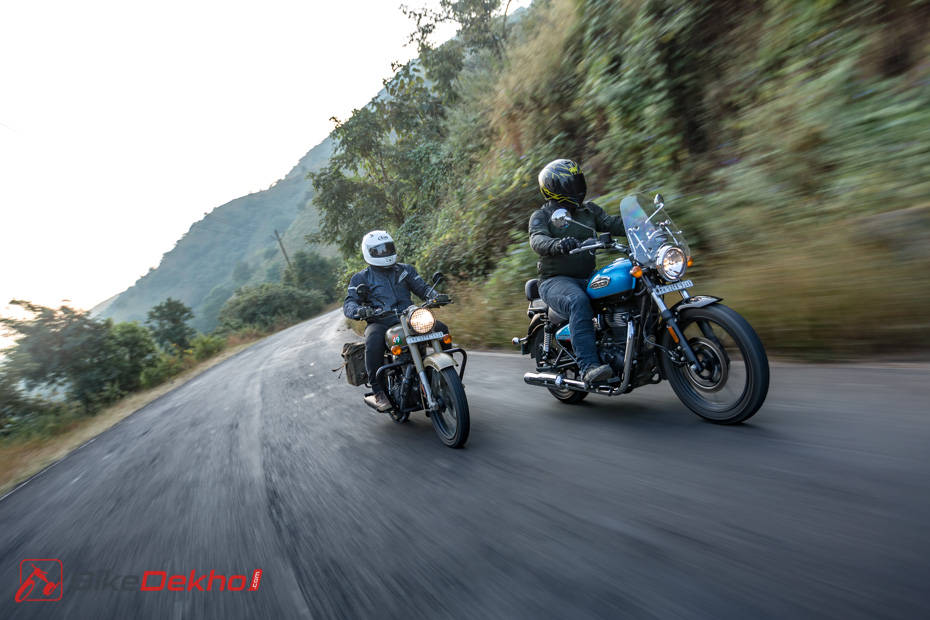5 Reasons Why You Should You Buy The Royal Enfield Meteor 350 Over The Classic 350 BS6
Modified On Dec 6, 2020 10:00 AM By Jehan Adil Darukhanawalafor Royal Enfield Meteor 350
- 71540 Views
- Write a comment
In what areas is the new RE single better than the cult icon?

The highly anticipated Royal Enfield Meteor 350 finally made it into the Indian market last month. It is the first bike on the new RE single-cylinder engine platform, the J-series, with the majority of the flaws of the old UCE mill rectified on this new engine. Still, this new engine has first appeared on a cruiser and not a roadster like the Classic 350, a much-loved and high-selling motorcycle from the brand. So, which one of the two RE bikes should you get? Here are five areas where the Meteor 350 outshines the aging Classic 350:

Performance
On paper, the new 349cc single-cylinder thumper is making a bit more power and a bit less torque, but is significantly quicker than the old UCE mill. The Meteor 350 takes 14.81 seconds to reach 100kmph from standstill while the Classic 350 BS6 took 22.8 seconds. Not only is this new motor quicker off the line, it also has better in-gear roll-on acceleration timings.

New Thump
You feel the new motor’s liveliness across the rev range with a new rumbling thump soundtrack that only gets better as the revs rise. The thump is more prominent on the new engine than on the BS6 version of the UCE mill, the latter’s intake noise can be heard more and the dug dug is quite subtle.

Refinement & Cruiseability
Speaking of enjoying the new soundtrack as the revs go higher, there are no harsh vibrations here to contend with. This new motor is counterbalanced, isolating the typical vibrations that one associates from such a single-cylinder motor. The Meteor can sustain speeds in the 100-110kmph region without breaking a sweat. There’s a mild buzz at 110kmph, nothing too troublesome though. In fact, the Classic 350 feels a lot more strained at 85kmph than the Meteor at 110kmph.

Handling
There’s a new double-downtube frame developed from scratch for the Meteor. The engine acts as a stressed member here with the bolted-on cradle section only used to mount the footpegs. Show the Meteor a set of corners and it doesn’t get too easily flustered. Directional changes also do not require much effort and it masks its 191kg kerb weight quite well. The footpegs do get grounded out quite easily though, reminding you of its limits. The Classic’s neutral handling is quite charming but not as enjoyable as the Meteor’s. Plus, it reminds the rider of its heft, communicating that it doesn’t like being hustled and to take it easy.

Features & Build Quality
One of the biggest upgrades from the Classic 350 to the Meteor 350 has to be the fit and finish levels on the bike. Every panel is put together well, with no seemingly glaring welds or inconsistent panel gaps. We absolutely love the paint quality on the large tank, although the choice of colours offered on the Supernova version could do with a rethink.


Then you have loads of new features like a digital round pod displaying trip and fuel related data, which is surrounded by an analogue speedometer. No tachometer here. What you do get is a small round pod called Tripper. It enables turn-by-turn navigation by pairing your smartphone to the system. The navigation system has been developed alongside Google, using the Google Maps database, which as we know is one of the most comprehensive and commonly used navigational assistants in the world.
If you do want to know more about why you should get the Meteor over the Classic, why not check out our video of the two Royal Enfield thumpers above. However, if you are still considering getting the Classic 350, wait for 24 hours and we shall give you four reasons why there’s still some life left in the old dog.
